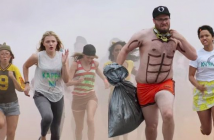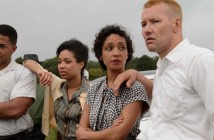
Editor’s Note: 10 Cloverfield Lane is currently playing in wide theatrical release.
Enthusiasts of 2008’s wholly fascinating Cloverfield have spent years desperately waiting for news of a follow-up to surface. Back in January, their wishes were granted when a teaser for 10 Cloverfield Lane hit both the Internet and screens showing Michael Bay’s 13 Hours. Fans (like myself) instantly recognized this parallel to the original’s teaser being released with Transformers in 2007, no doubt an orchestrated similarity. Nearly hours afterward, we uncovered an Augmented Reality Game (essentially background on the movie through online detective work) which, quite fittingly, was also something that accompanied the first film. Like a finely-tuned machine, this throwback style of marketing worked, and we were quickly building up 10 Cloverfield Lane in our minds to be a gargantuan monument of a sequel. Time flew, and March 10th came sooner than expected, prompting all of us to flock to our nearest IMAX screens with the highest expectations.
Beyond thrills, 10 Cloverfield Lane is more simply (and more meaningfully) a film about fear.
 The film we got didn’t meet those expectations, but as it went on, it demolished them, provided new expectations, and forced us to realize why those old expectations would have left us unsatisfied. 10 Cloverfield Lane is not a codependent revival of an 8 year-old property, its objective isn’t solely to make fans squeal. It’s not a gargantuan monument of a sequel, it’s a gargantuan monument in its own right. Here we have an endlessly tense, engrossing thriller with a fully developed character arc, thematic weight, and performances that put other thrillers to shame. We follow Mary Elizabeth Winstead’s Michelle, a woman we can gather (through classical visual storytelling) is running from a presumably crumbling relationship. That fear puts her in a car, then mere scenes later, through a guardrail and out of consciousness. She soon regains that consciousness to find herself captive in a doomsday bunker home to the infinitely freaky Howard Stambler (played insidiously by John Goodman) and the infinitely less-freaky Emmett, whom Michelle soon befriends. Howard claims the outside is contaminated from a chemical attack, but with doubts in their mind and their hearts set on surviving, Michelle and Emmett seek both the truth and a way out.
The film we got didn’t meet those expectations, but as it went on, it demolished them, provided new expectations, and forced us to realize why those old expectations would have left us unsatisfied. 10 Cloverfield Lane is not a codependent revival of an 8 year-old property, its objective isn’t solely to make fans squeal. It’s not a gargantuan monument of a sequel, it’s a gargantuan monument in its own right. Here we have an endlessly tense, engrossing thriller with a fully developed character arc, thematic weight, and performances that put other thrillers to shame. We follow Mary Elizabeth Winstead’s Michelle, a woman we can gather (through classical visual storytelling) is running from a presumably crumbling relationship. That fear puts her in a car, then mere scenes later, through a guardrail and out of consciousness. She soon regains that consciousness to find herself captive in a doomsday bunker home to the infinitely freaky Howard Stambler (played insidiously by John Goodman) and the infinitely less-freaky Emmett, whom Michelle soon befriends. Howard claims the outside is contaminated from a chemical attack, but with doubts in their mind and their hearts set on surviving, Michelle and Emmett seek both the truth and a way out.
But beyond thrills, 10 Cloverfield Lane is more simply (and more meaningfully) a film about fear. It’s what drives Michelle away from her relationship and into the confines of Howard’s bunker, imprisoned by that fear, unable to avoid it. Howard is driven mad by his own paranoia, which makes Michelle even more scared. In her head, Howard (an always-lording force and a physical representation of what she fears in life) should be a single, resolute object to overcome, but what drove him to build this bunker? What’s Howard afraid of? This one thought holds Michelle in an unsure, rattled, and confused state of all-encompassing vulnerability. She’s strong, we see that firsthand, but she isn’t sure what to do. After all, what you don’t know terrifies you the most. So, she makes the best of it, forgetting for brief spells that she’s in this bunker against her will, but reality hits her like a ton of bricks as often as we see paranoia affect her thinking. Attempts to get out of this state (out of the bunker) always bring her face-to-face with the fear keeping her there, and though she consistently fails to overcome it, we see her gradually-strengthening resolve slowly work its way into her actions. Soon Michelle’s confronting fear head-on, not running away, and against a backdrop of unadulterated adrenaline, her captivating arc violently comes to a head.
When it’s not horrifying, it’s heavily dramatic. When it’s neither, it’s smartly funny. And, when it’s none of those, it’s awe-inspiring.
It’s an arc that doesn’t just speak to overcoming fear, but also seems to echo characteristics of domestic abuse, more specifically the psychology of being in such a scenario, and what lies in the way of escaping one. At this we’re left to wonder if, potentially, the relationship she fled from in the opening was abusive. Mary Elizabeth Winstead’s dynamic with John Goodman is a horrifyingly brilliant thing to witness both before and after considering this, the former giving an intricate, powerful performance that instantly creates (not begs for) empathy, and the latter chilling you to your damn bones with every second of screentime. John Gallagher Jr. as Emmett would seem to just be the comic relief, but plays into everything very nicely, providing warmth for this cold situation but keeping us in reality, reminding us it’s still cold. Dan Trachtenberg, in his feature debut, crafts scenes of nail-biting tension that either defy predictability or telegraph themselves and make us dread what’s coming. When it’s not horrifying, it’s heavily dramatic. When it’s neither, it’s smartly funny. And, when it’s none of those, it’s awe-inspiring.
10 Cloverfield Lane may not be a continuation of Cloverfield, but it’s more than that. It’s more than just a crazy ride, it’s more than just a thriller, it’s a landmark, a powerhouse of psychological triumph. Maybe the Cloverfield name is a signifier of brilliant stories that defy their genres to mean something profound? If that’s true, then 10 Cloverfield Lane fits right in.
10 Cloverfield Lane, while not strictly a continuation of 2008's Cloverfield, is a landmark and a powerhouse of psychological triumph.



